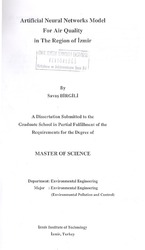Please use this identifier to cite or link to this item:
https://hdl.handle.net/11147/3079Full metadata record
| DC Field | Value | Language |
|---|---|---|
| dc.contributor.advisor | Tayfur, Gökmen | - |
| dc.contributor.author | Birgili, Savaş | - |
| dc.date.accessioned | 2014-07-22T13:50:50Z | - |
| dc.date.available | 2014-07-22T13:50:50Z | - |
| dc.date.issued | 2002 | - |
| dc.identifier.uri | http://hdl.handle.net/11147/3079 | - |
| dc.description | Thesis (Master)--Izmir Institute of Technology, Environmental Engineering, Izmir, 2002 | en_US |
| dc.description | Includes bibliographical references (leaves: 68-72) | en_US |
| dc.description | Text in English; Abstract: Turkish and English | en_US |
| dc.description | xiv, 88 leaves | en_US |
| dc.description.abstract | In this study, a systematic approach to the development of the artificial neural networks based forecasting model is presented. S02, and dust values are predicted with different topologies, inputs and transfer functions. Temperature and wind speed values are used as input parameters for the models. The back-propagation learning algorithm is used to train the networks. R 2 (correlation coefficient), and daily average errors are employed to investigate the accuracy of the networks. MATLAB 6 neural network toolbox is used for this study. The study results indicate that the neural networks are able to make accurate predictions even with the limited number of parameters. Results also show that increasing the topology of the network and number of the inputs, increases the accuracy of the network. Best results for the S02 forecasting are obtained with the network with two hidden layers, hyperbolic tangent function as transfer function and three input variables (R2 was found as 0,94 and daily average error was found as 3,6 j..lg/m3).The most accurate results for the dust forecasting are also obtained with the network with two hidden layer, hyperbolic tangent function as transfer function and three input variables (R2 was found as 0,92 and daily average error was found as 3,64 j..lg/m3).S02 and dust predictions using their last seven days values as an input are also studied, and R2 is calculated as 0,94 and daily average error is calculated as 4,03 Jlg/m3 for S02 prediction and R2 is calculated as 0,93 and daily average error is calculated as 4,32 Jlg/m3 for dust prediction and these results show that the neural network can make accurate predictions. | en_US |
| dc.language.iso | en | en_US |
| dc.publisher | Izmir Institute of Technology | en_US |
| dc.rights | info:eu-repo/semantics/openAccess | en_US |
| dc.subject.lcsh | Neural networks (Computer science) | en |
| dc.title | Artificial Neural Networks Model for Air Quality in the Region of Izmir | en_US |
| dc.type | Master Thesis | en_US |
| dc.institutionauthor | Birgili, Savaş | - |
| dc.department | Thesis (Master)--İzmir Institute of Technology, Environmental Engineering | en_US |
| dc.relation.publicationcategory | Tez | en_US |
| dc.identifier.wosquality | N/A | - |
| dc.identifier.scopusquality | N/A | - |
| item.openairecristype | http://purl.org/coar/resource_type/c_18cf | - |
| item.languageiso639-1 | en | - |
| item.openairetype | Master Thesis | - |
| item.grantfulltext | open | - |
| item.fulltext | With Fulltext | - |
| item.cerifentitytype | Publications | - |
| Appears in Collections: | Master Degree / Yüksek Lisans Tezleri Sürdürülebilir Yeşil Kampüs Koleksiyonu / Sustainable Green Campus Collection | |
Files in This Item:
| File | Description | Size | Format | |
|---|---|---|---|---|
| T000155.PDF | MasterThesis | 28.98 MB | Adobe PDF |  View/Open |
CORE Recommender
Sorry the service is unavailable at the moment. Please try again later.
Items in GCRIS Repository are protected by copyright, with all rights reserved, unless otherwise indicated.